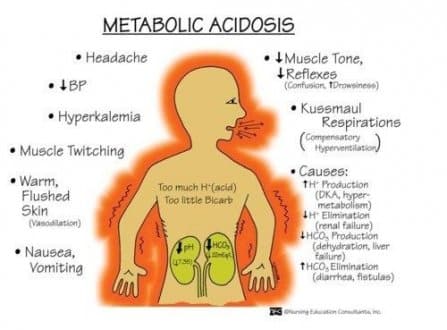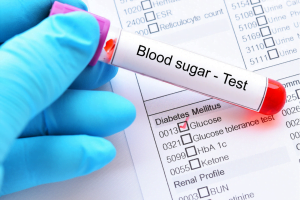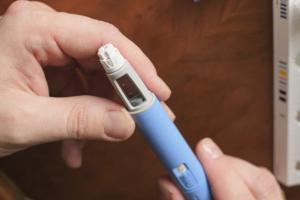What is metabolic acidosis (MA)?
Metabolic acidosis is a condition where your body is making too much acid than it is getting rid of. As a result, there is too much acid in the body. Metabolic acidosis usually occurs when your lungs and kidneys are unable to maintain your body’s normal pH balance. Your blood acidity is measured using pH level. If your pH level is low, you have more acid in the blood. The blood pH level in people who are healthy is between 7.35 and 7.45. MA occurs when the blood pH level falls below 7.35. In case your pH level is more than 7.45, then it means you have too many bases in the blood, a condition known as alkalosis. If not diagnosed, MA could result in a condition known as acidemia, where the pH level in the blood is low because the body is producing more hydrogen ions. Acidemia could also arise when the kidney fails to form bicarbonate. It is advisable to consider MA as a sign of underlying medical condition. For MA to be successfully treated, identification of the underlying medical condition is important. There are instances when MA could become serious and lead to coma or even death. However, some patients have mild MA that is not life threatening. There are certain risk factors which increases your chances of getting MA. If you are diabetic, have kidney failure, are obese, are suffering from dehydration, or are using aspirin, you have a higher risk of getting metabolic acidosis.
Metabolic acidosis signs and symptoms
The symptoms of metabolic acidosis usually differ depending on the cause. However, patients with this condition usually experience the following signs and symptoms of MA:
- Rapid breathing
- Headache
- Confusion
- Increased heart rate
- Sleepiness
- Fatigue
- Jaundice
- Lack of appetite
If you are experiencing any of the above signs and symptoms of metabolic acidosis, you should book an appointment to visit your doctor. They will carry out blood tests to try and identify the cause of your symptoms.
Causes
There are different factors which can cause MA. Metabolic acidosis occurs when there is a problem with the kidneys, so that they cannot eliminate excess acids from the blood or they excrete excess base.
The following are the main causes of metabolic acidosis
Diabetic ketoacidosis
Diabetic ketoacidosis is a life threatening condition characterized by high acid in the blood. It normally occurs when there is too much sugar in the bloodstream for long periods. When you are diabetic, you can become dehydrated. When your body does not produce enough amounts of insulin, the body will start to burn fat for energy. This may produce acids known as ketones. Too many ketones in the bloodstream may lead to blood acidity. Patients who are diagnosed with type 1 diabetes are prone to getting diabetic ketoacidosis, because their bodies cannot produce insulin. The levels of your ketones could also rise when you skip a meal or you are feeling stressed or sick.
Renal tubular acidosis
Renal tubular acidosis is a condition where your kidney is unable to remove acids via urine, which leads to high levels of acid in the bloodstream. In healthy people, the kidney excretes acids from the bloodstream through the urine. However, in case of kidney disease, the body will experience high amount of acid because the kidney cannot excrete excess acids from the bloodstream.
Hyperchloremic acidosis
Hyperchloremic acidosis is a condition characterized by low plasma bicarbonate concentration and high plasma chloride concentration. Hyperchloremic acidosis is normally characterized by a rise in urine anion gap as a result of the kidney failing to secrete ammonia. This condition usually occurs when the body loses base because of renal loss or gastrointestinal loss. For example, in case of severe diarrhea or vomiting, it may lead to decrease in bicarbonate levels. This may lead to increase in blood acid levels.
Lactic acidosis
Patients who are diagnosed with lactic acidosis have kidneys that are not able to excrete excess acid from their bloodstream. Lactic acidosis usually occurs when the body does not have enough oxygen required to break down glycogen and glucose. There are different factors such as heart disease which can cause lactic acidosis. In case of cardiac arrest, there will be inadequate oxygen and blood flow in the entire body. This may result in lactic acidosis. Also, if you engage in excessive exercise when your body lacks enough oxygen, it may lead to lactic acidosis. Other factors that can cause lactic acidosis include excessive drinking or alcoholism, significant drop in blood pressure, severe bacterial or viral infection that lead to sepsis, and cancer.
Treatment
The treatment for metabolic acidosis varies depending on the underlying cause. In case you suspect that you have MA, you should visit your doctor immediately. When MA is diagnosed early, it can help in successful recovery. A doctor may perform different blood and urine tests to try and identify the underlying cause of MA. Examples of tests that can be performed are arterial blood gas, basic metabolic panel test, lactic acid test, urine ketones test, arterial blood gas analysis or urine pH test. In case these tests are performed together, they can help identify different acidosis types. In case diagnosis shows you have respiratory acidosis, your doctor may perform different tests such as pulmonary function tests and chest x-rays to check if your lungs are healthy. If your doctor suspects you are suffering from metabolic acidosis, they may perform a urine test to check your pH levels.
Once the underlying cause of MA is known, treatment can begin. Sodium bicarbonate is a common treatment that is prescribed by doctors to help increase the pH levels. Sodium bicarbonate can be administered orally or using an IV pump. In addition, you will require IV fluids administered intravenously using a needle. In case you have diabetic ketoacidosis, insulin treatment will be needed. To reduce the risk of metabolic acidosis, it is important you drink enough fluids so that you stay hydrated. If you are diabetic, you should keep your levels of blood sugar under control, so as to reduce the risk of getting diabetic ketoacidosis. Also, to avoid a build-up of lactic acid, you should stop taking alcohol.
—
Disclaimer: Please note that the contents of this community article are strictly for informational purposes and should not be considered as medical advice. This article, and other community articles, are not written or reviewed for medical validity by Canadian Insulin or its staff. All views and opinions expressed by the contributing authors are not endorsed by Canadian Insulin. Always consult a medical professional for medical advice, diagnosis, and treatment.





